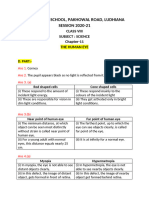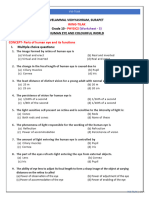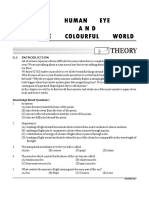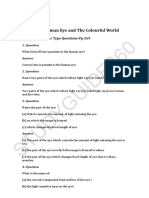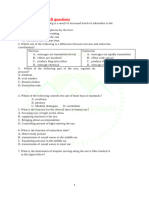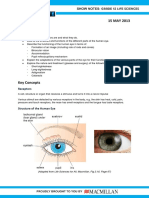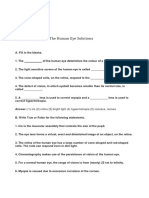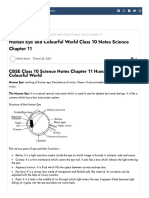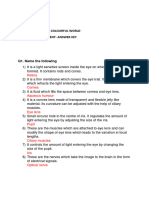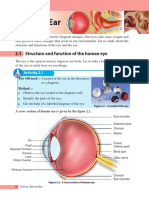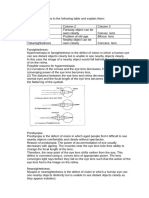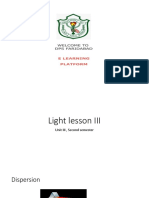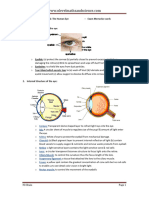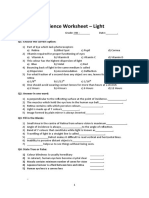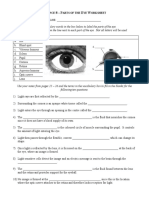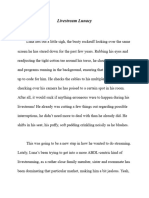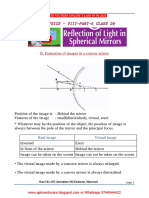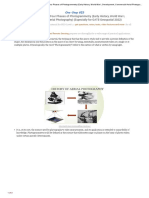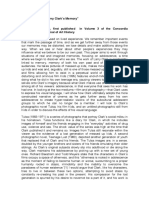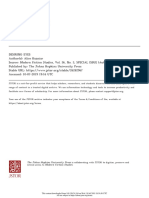02 - Human Eye and Colourful World - X - SSM
02 - Human Eye and Colourful World - X - SSM
Uploaded by
DøomCopyright:
Available Formats
02 - Human Eye and Colourful World - X - SSM
02 - Human Eye and Colourful World - X - SSM
Uploaded by
DøomOriginal Title
Copyright
Available Formats
Share this document
Did you find this document useful?
Is this content inappropriate?
Copyright:
Available Formats
02 - Human Eye and Colourful World - X - SSM
02 - Human Eye and Colourful World - X - SSM
Uploaded by
DøomCopyright:
Available Formats
CHAPTER
HUMAN EYE AND COLOURFUL WORLD
2
♦ Introduction to Human Eye ♦ Defects of Vision
♦ Human Eye parts and Functions ♦ Refraction of light through a glass prism
♦ Power of Accomodation ♦ Dispersion of White Light
SYNOPSIS 1
1. Introduction to Human Eye
Our eyes enable us to see the beautiful world around us. The most important part of our eyes is a
convex lens inside it that is made of living cells.
The human eye is like a camera having a lens on one side and a sensitive screen called the retina on the
other.
2. Human Eye parts and Functions
The essential parts of a human eye are shown in figure.
a) Sclerotic: It is the outermost converging of the eye ball. It is made of white tough fibrous tissues.
Its function is to house and protect vital internal parts of eye.
b) Cornea: It is the front bulging part of the eye. It is made of transparent tissues. Its function is to
act as a window to world. i.e., to allow the light to enter in the eye ball.
c) Choroid: It is a grey membrane attached to the sclerotic from the inner side. Its function is to
darken the eye from inside and, hence, prevent any internal reflection.
d) Optic Nerve: It is a bundle of approximately 70,000 nerves originating from brain and entering
eye ball from behind. Its function is to carry optical message (visual messages) to the brain.
Human Eye and Colourful World 2. 1
e) Retina: The optic nerve on entering the ball, spreads like a canopy, such that each nerve and
attaches itself to the choroid. The nerve endings form a hemi-spherical screen called retina.
These nerve endings on the retina are sensitive to visible light. On the retina are two important
areas which we will discuss separately. The function of retina is to receive the optical image of the
object and then convert it to optical pulses. These pulses are then sent to the brain through optic
nerve.
f) Yellow spot: It is a small area facing the eye lens. It has high concentration of nerve endings and
is slightly raised as well as slightly yellow in colour. Its function is to very clear image by sending
a large number of optical pulses to brain.
g) Blind spot: It is a region on the retina, where the optic nerve enters the eye ball. It has no nerve
endings and hence, is insensitive to the light. It does not seem to have any function. Any image
formed on this spot is not visible.
h) Crystalline lens: It is a double convex lens made of transparent tissues. It is held in position by
a ring of muscles, commonly called ciliary muscles. Its function is to focus the images of different
objects clearly on the retina.
i) Ciliary muscles: It is a ring of muscles which holds the crystalline lens in position. When these
muscles relax, they increase the focal length of the crystalline lens and vice versa. Its function is to
alter the focal length of crystalline lens so that the images of the objects, situated at different
distances, are clearly focussed on the retina.
j) Iris: It is a circular diaphragm suspended in front of the crystalline lens. It has a tiny hole in the
middle and is commonly called pupil. It has tiny muscles arranged radially around the pupil.
These muscles can increase or decrease the diameter of the pupil. The iris is heavily pigmented.
The colour of eyes depends upon colour of pigment. The function of iris is to control the amount
of light entering in eye. This is done by increasing or decreasing the diameter of pupil.
2. 2 10th Class Physics
k) Vitreous humour: It is a dense jelly like fluid, slightly grey in colour, filling the part of eye
between crystalline lens and retina. Its function is (i) to prevent the eye ball from collapsing due to
change in atmospheric pressure (ii) in focussing the rays clearly on the retina.
l) Aqueous humour: It is a watery, saline fluid, filling the part of the eye between the cornea and
the crystalline lens. Its function is (i) to prevent front part of the eye ball from collapsing with the
change in atmospheric pressure (ii) to keep the cornea moist.
WORKSHEET 1
1. Which of the following parts of the eye has enormous number of photo-sensitive cells?
A) Iris B) Pupil C) Retina D) Cornea
2. The focal length of the eye lens is adjusted by the
A) vitreous humour B) aqueous humour C) ciliary muscles D) optic nerves
3. In the human eye, the function of the optic nerves is to
A) adjust the focus of the eye lens B) transmit electrical signals to the brain
C) control the number of rod and cone cells D) convert light signals into electrical signals
4. The primary function of the crystalline lens in the human eye is to
A) reduce the intensity of light B) focus the incident light rays
C) adjust the size of the pupil D) filter out the dust particles
5. The given diagram is that of the human eye.
In the given diagram, the parts labelled as I and II are respectively the
A) eye lens and the cornea B) pupil and the eye lens
C) cornea and the pupil D) pupil and the iris
Human Eye and Colourful World 2. 3
Part of eye Function
i Iris a Controls the amount of light entering into the eye
ii Cilliary muscle b Senses the real image
iii Pupil c Controls the power of eye lens
6.
iv Retina d Controls the size of pupil
The alternatives in the given table can be correctly matched as
A) i → a, ii → c, iii → b, iv → d B) i → a, ii → b, iii → c, iv → d
C) i → d, ii → c, iii → a, iv → b D) i → d, ii → c, iii → b, iv → a
Four statements about the blind spot of the human eye:
I It is devoid of photosensitive cells.
II No image is formed at the blind spot.
III It connects the optic nerves to the retina.
7.
IV Its malfunctioning makes a person blind.
Which of the given statements is incorrect?
A) I B) II C) III D) IV
8. When we look at a distant object, the ciliary muscles , making the eye lens .
This the focal length of the eye lens so that the image of that object gets focused on the
retina.
The information in which alternative completes the given statements?
A) i ii iii B) i ii iii
get released thicker decreases contract thicker increases
C) i ii iii D) i ii iii
get released thinner increases contract thinner decreases
2. 4 10th Class Physics
9. Which of the following pairs of eye parts is responsible for controlling the amount of light entering into
the eye?
A) Iris and pupil B) Cornea and eye lens
C) Cilliary muscles and iris D) Cilliary muscles and pupil
10. Tina has a defect in her eyes. She is not able to contract her iris properly. As a result of the defect in her
eyes, Tina will not be able to see
A) in dim light B) near objects C) in bright light D) distant objects
11. Which of the following eye parts is not in contact with the eye lens?
A) Vitreous humour B) Ciliary fibres C) Cornea D) Iris
12. Which part of the human eye contracts and relaxes in order to adjust the focal length of the lens?
A) Iris B) Pupil C) Blind spot D) Ciliary muscles
13. The ciliary muscles of the human eye contract and relax in order to
A) adjust the size of the eyeball B) adjust the focal length of the lens
C) control the amount of light entering the eye D) prevent foreign elements from entering the eye
14. In the human eye, light is converted into electrical signals by the
A) retina B) cornea C) blind spot D) optical nerves
15. The image formed by the eye lens on the retina is
A) real, inverted, and large B) virtual, erect, and large
C) real, inverted, and diminished D) virtual, erect, and diminished
3. Power of Accomodation
Have you wondered why the eye is able to focus the images of objects lying at various
distances?
It is made possible because the focal length of the human lens can change i.e., increase or decrease,
depending on the distance of objects. It is the ciliary muscles that can modify the curvature of the lens
to change its focal length.
Human Eye and Colourful World 2. 5
To see a distant object clearly, the focal length of the lens should be larger. For this, the ciliary muscles
relax to decrease the curvature and thereby increase the focal length of the lens. Hence, the lens becomes
thin. This enables you to see the distant object clearly.
To see the nearby objects clearly, the focal length of the lens should be shorter. For this, the ciliary
muscles contract to increase the curvature and thereby decrease the focal length of the lens. Hence, the
lens becomes thick. This enables you to see the nearby objects clearly.
The ability of the eye lens to adjust its focal length accordingly as the object distances is called power
of accommodation.
r The minimum distance of the object by which clear distinct image can be obtained on the retina
is called least distance of distinct vision. It is equal to 25 cm for a normal eye. The focal length
of the eye lens cannot be decreased below this minimum limit of object distance.
r The far point of a normal eye is infinity. It is the farthest point up to which the eye can see
objects clearly.
The range of vision of a normal eye is from 25 cm to infinity.
Have you ever thought why animals’ eyes are positioned on their heads?
This is because it provides them with the widest possible field of view. Our eyes are located in front of
our face. One eye provides 150° wide field of view while both eyes simultaneously provide 180° wide
field of view. It is the importance of the presence of two eyes as both eyes together provide the three-
dimensional depth in the image.
4. Defects of Vision
The loss of power of accommodation of an eye results in the defects of vision.
There are three defects of vision called refractive defects. They are myopia, hypermetropia, and
presbyopia. In this section, we will learn about these defects of vision in detail.
1. Myopia (short sightedness)
Myopia is a defect of vision in which a person clearly sees all the nearby objects, but is unable
to see the distant objects comfortably and his eye is known as a myopic eye.
2. 6 10th Class Physics
A myopic eye has its far point nearer than infinity. It forms the image of a distant object
in front of its retina as shown in the figure.
Myopia is caused by
i. increase in curvature of the lens
ii. increase in length of the eyeball
Since a concave lens has an ability to diverge incoming rays, it is used to correct this defect
of vision. The image is allowed to form at the retina by using a concave lens of suitable power as
shown in the given figure.
Power of the correcting concave lens
1 1 1
The lens formula − = can be used to calculate the focal length and hence the power of
v u f
the myopia correcting lens.
In this case,
Object distance, u = ∞
Human Eye and Colourful World 2. 7
Image distance, v = person’s far point
Focal length, f =?
Hence, lens formula becomes
1 1 1
− =
far po int ∞ focal lenght
1 1
−0 =
far po int focal lenght
In case of a concave lens, the image is formed in front of the lens i.e., on the same side of the
object.
∴ Focal length = – Far point
Now, Power of the required lens
1
( P) = −
f ( in m )
Example: A person can clearly see up to a maximum distance of 100 cm only. Calculate the power of the
required lens that can correct his defect?
Solution: Since the person is not able to see farther than 100 cm, he is suffering from myopia. Hence, a
concave lens of suitable power is required to correct his defect. The focal length of the lens is
given by his far point i.e.,
Focal length = – Far point
= 100 cm
1 1
∴ Power of the lens = − =−
f ( in m ) 100 m
100
Hence, a concave lens of power –1 D is required to correct the given defect of vision.
2. Hypermetropia (Long sightedness)
Hypermetropia is a defect of vision in which a person can see distant objects clearly and
distinctively, but is not able to see nearby objects comfortably and clearly.
So, now you can easily represent the problem with a hypermetropic eye with the help of a
diagram. It is shown in the given figure.
2. 8 10th Class Physics
A hypermetropic eye has its least distance of distinct vision greater than 25 cm.
Hypermetropia is caused due to
i. reduction in the curvature of the lens
ii. decrease in the length of the eyeball
Since a convex lens has the ability to converge incoming rays, it can be used to correct this
defect of vision, as you already have seen in the animation. The ray diagram for the corrective
measure for a hypermetropic eye is shown in the given figure.
Human Eye and Colourful World 2. 9
Power of the correcting convex lens
1 1 1
Lens formula, − = can be used to calculate focal length f and hence power P of the
v u f
correcting convex lens, where
Object distance, u = –25 cm, normal near point
Image distance, v = defective near point
Hence, the lens formula is reduced to
1 1 1
+ =
v 25 f
Example: The defective near point of an eye is 150 cm. Calculate the power of the correcting convex lens
that would correct this defect of vision.
Solution: Given that, hypermetropic near point = 150 cm
Hence, image distance, v = – 150 cm
We have the correction formula,
1 1 1
= +
f v 25
1 1 1
= +
f −150 25
1 −1 + 6 5
= =
f 150 150
150
f = cm
5
f = 0.3m
∴ Power of the correcting convex lens,
1 1
P= = = 3.3D
f ( in m ) 0.3
Hence, a convex lens of power 3.3 D is required to correct the given defect of vision.
3. Presbyopia (Ageing vision defect)
Presbyopia is a common defect of vision, which generally occurs at old age. A person suffering
from this type of defect of vision cannot see nearby objects clearly and distinctively. A presbyopic
2. 10 10th Class Physics
eye has its near point greater than 25 cm and it gradually increases as the eye becomes older.
Presbyopia is caused by the
i. weakening of the ciliary muscles
ii. reduction in the flexibility of the eye lens
i. A person with presbyopia cannot read letters without spectacles. It may also happen
that a person suffers from both myopia and hypermetropia. This type of defect can be
corrected by using bi-focal lenses. A bifocal lens consists of both convex lens (to correct
hypermetropia) and concave lens (to correct myopia).
ii. It is a common misconception among people that the use of spectacles “cures” the defects
of vision. However, this is not true as spectacles only “restore” the defects of vision to the
normal value.
iii. Cataract
It is also one of the eye defects found commonly in people of older ages. In this defect, the
crystalline lens becomes milky and cloudy. This condition is also known as cataract. This
causes partial or complete loss of vision. This loss of vision can be restored by removing
the cataract by means of a cataract surgery. The use of any kind of spectacle lenses does
not provide any help against this defect of vision.
WORKSHEET 2
1. The range of vision of a normal human eye lies between
A) 25 m and infinity B) 2.5 m and 5 km C) 2.5 cm and 5 km D) 25 cm and infinity
2. Pappu can see clearly and distinctly only those objects that are located up to a distance of 120 cm. He
uses spectacles to correct this defect of vision.
What is the power of Pappu’s spectacles?
A) –0.60 D B) –0.83 D C) –1.20 D D) –1.66 D
Human Eye and Colourful World 2. 11
3. Imran can see clearly and distinctly only those objects that are located up to a distance of 1.5 m. He
uses spectacles of a certain power to correct his defect.
What is the power of Imran’s spectacles?
A) –1.5 D B) –0.67 D C) 0.67 D D) 1.5 D
4. Myopia is a defect of vision caused by
A) a decrease in the retinal distance from the lens B) a decrease in the diameter of the eyeball
C) an increase in the thickness of the lens D) an increase in the curvature of the lens
5. Billu can see clearly and distinctly only those objects that are located up to a certain distance. To
correct this defect of vision, he uses spectacles having a power of –2.5 D.
What is the far point for Billu’s eyes?
A) –20 cm B) –40 cm C) 20 cm D) 40 cm
6. Shyam views a certain object and finds that it is not properly visible to him. The image of the said object
is formed by his eye lens 3 cm away from the pupil of his eye.
Shyam can correct the defect in his vision by using
A) convex lens B) bifocal lens C) concave lens D) cylindrical lens
7. Which of the following lenses is used to correct the defect of hypermetropia?
A) Bifocal lens B) Convex lens C) Concave lens D) Cylindrical lens
8. While sitting on the first bench, Mutum finds it difficult to read what is written on the blackboard.
However, he can clearly see the same when he sits on the last bench.
It can be concluded that Mutum is suffering from
A) myopia B) cataract C) astigmatism D) hypermetropia
2. 12 10th Class Physics
9. The given figure shows two rays emerging from an object placed at 25 cm from a presbyopic eye.
A) B)
C) D)
10. Consider three statements regarding the defects of eye.I. If the size of the eye ball decreases, then the
person suffers from myopia.II. If the near point of eye becomes greater than 25 cm, then the person is
said to suffer from hypermetropia.III. A person, at older age, suffering from presbyopia uses a bifocal
lens for correction.
Among the given statements,
A) only statement I is correct B) onlystatement II is correct
C) both statements I and II are correct D) both statements II and III are correct
5. Refraction of light through a glass prism
When a ray of light is incident on a rectangular glass slab, after refracting through the slab, it gets
displaced laterally. As a result, the emergent ray comes out parallel to the incident ray. Does the same
happen if a ray of light passes through a glass prism?
Unlike a rectangular slab, the sides of a glass prism are inclined at an angle called the angle of prism.
Therefore, a ray of light incident on its surface, after refraction, will not emerge parallel to the incident
light ray (as seen in the case of a rectangular slab).
Human Eye and Colourful World 2. 13
Refraction of light through a glass prism
To observe the refraction of light through a glass prism, we can perform the following activity.
Take a triangular glass prism, paper sheet, and a few drawing pins. Fix the sheet on a drawing board
with the help of drawing pins. Now, place the glass prism on the sheet and draw the outline MNP of
the prism on the sheet (as shown in the figure). Draw a straight line AB on the sheet in such a way that
it makes some angle with the face MN of the prism. Now, fix two pins on this line and mark them
as R and S respectively.
Now, observe the pins R and S through the other side of the prism. Move your head laterally to see the
two pins R and S in a straight line. Fix a pin on the sheet near the prism on your side and mark it as T.
Repeat the same step and try to observe the three pins R, S, and T in a straight line. Fix another pin on
the sheet so that all four pins appear to be in a straight line when looked through the prism. Draw a
straight line CD that passes through the third and the fourth pin i.e., T and Wrespectively (see figure).
Now, remove the prism and join points B and C. The straight line AB, BC, and CDshows the path of
the light ray. It is clear that the path of light is not a straight line since light bends towards the base NP.
What causes the light to bend when passed through a prism?
2. 14 10th Class Physics
Light bends because of refraction that takes place at points B and C respectively, when it tries to enter
and emerge from the prism.
Now, draw a straight line normal to side MN and let it pass through point B. Similarly, draw a
straight line normal to side MP and let it pass through point C.
Here, line AB = Incident ray
Line BC = Refracted ray
Line CD = Emergent ray
Angle i = Angle of incidence
Angle r = Angle of refraction
Angle e = Angle of emergence
Angle = Angle of deviation
Hence, you will get the path of light ray AB when it travels through a glass prism. The ray AB will bend
towards the normal at point B and follow the path BC. Again, it bends away from the
normal at C, when it tries to emerge from the prism. This is because the refractive index of air is
less than that of glass. Thus, the incident ray AB will not follow a straight line BE.
The extent of deviation of the light ray from its path BE to path CD is known as the angle of
deviation ( ).
6. Dispersion of White Light
Do you know what happens when you take white light as incident ray instead of single ray?
A beam of white light will split into a band of seven colours. The splitting of a beam of white light into its
seven constituent colours, when it passes through a glass prism, is called the dispersion of light.
Human Eye and Colourful World 2. 15
Dispersion of white light by a prism
Isaac Newton was one of the greatest mathematicians and physicists the world ever saw. In 1665, with
the help of an experiment he showed that white sunlight is actually a mixture of seven different colours.
These constituent colours of white light can be separated with the help of a glass prism.
Take a glass prism and allow a narrow beam of sunlight to fall on one of its rectangular surfaces. You
will obtain a coloured spectrum with red and violet colour at its extreme. Try to obtain a sharp coloured
band on the screen by slightly rotating the prism. Count the colours of the band and write the sequence
of the colours.
Do you know why white light gets dispersed into seven colours?
When a beam of white light AB enters a prism, it gets refracted at point B and splits into its seven
constituent colours, viz. violet, indigo, blue, green, yellow, orange, and red. The acronym for the seven
constituent colours of white light is VIBGYOR. This splitting of the light rays occurs because of
the different angles of bending for each colour. Hence, each colour while passing through the
prism bends at different angles with respect to the incident beam. This gives rise to the formation of the
colour spectrum.
Can you say which colour undergoes maximum deviation?
Violet light bends the most whereas red colour deviates least.
However, Newton did not stop at this point. He thought that if seven colours can be obtained from a
white light beam, is it possible to obtain white light back from the seven colours?
For this, he placed an inverted prism in the path of a colour band. He was amazed to see that only a
beam of white light comes out from the second prism. It was at this point that Newton concluded that
white light comprises of seven component colours.
2. 16 10th Class Physics
Formation of a rainbow
The rainbow is a natural phenomenon in which white sunlight splits into beautiful colours by water
droplets, which remain suspended in air after the rain.
If we stand with our back towards the sun, then we can see the spectrum of these seven colours.
Do you know why a rainbow is shaped similar to an arc?
This is because the rainbow is formed by the dispersion of white light by spherical water droplets. It is
the shape of the water droplets that gives the rainbow an arc shape.
A rainbow appears arc-shaped for an observer on ground. However, if he sees the rainbow from an
airplane, then he will be able to see a complete circle. This is because he can observe the drops that are
above him as well as below him.
Human Eye and Colourful World 2. 17
WORKSHEET 3
1. The given figure represents a danger sign.
Dangers signs are painted in red because the colour red
A) scatters the least B) is pleasant to the eye
C) is the brightest colour D) can be clearly seen in the dark
2. Atmospheric particles scatter light the most because it has the wavelength
among the visible spectrum.
The information in which alternative completes the given statement?
A) i ii B) i ii
violet shortest blue longest
C) i ii D) i ii
yellow shortest red shortest
3. The sun appears during noon because the light coming from the sun travels a
relatively distance through earth’s atmosphere. Hence, of the sunlight gets
scattered.
A) B) i ii iii
i ii iii
a negligible
red larger most red less er
portion
C) i ii iii D) i ii iii
a negligible
white larger most white less er
portion
4. In space, the surrounding sky appears to be dark because
A) the outer space lacks atmosphere B) scattering is prominent in the outer space
C) the outer space is actually dark in colour D) dispersion is impossible in the outer space
2. 18 10th Class Physics
5. Which of the following statements is correct?
A) The refractive index of earth’s atmosphere keeps decreasing as one moves toward its surface.
B) The atmospheric refraction of light causes the sun to be visible a little time before sunrise and a
little time after sunset.
C) When seen through hot air, objects seem to flicker because of the Tyndall effect.
D) A rainbow is formed only because of the scattering of light by water droplets present in the
atmosphere.
6. Rainbow is a natural phenomenon visible on rainy days. It is caused by the dispersion and internal
reflection of sunlight by suspended water droplets present in the atmosphere. This is shown in the given
figure.
Dispersion of light takes place at
A) point I only B) point III only C) points I and III D) points II and III
7. Which of the following statements is incorrect about the Tyndall effect?
A) Tyndall effect happens because of the scattering of light.
B) Tyndall effect cannot be observed in a perfectly homogeneous medium.
C) The path of a light beam can be seen in vacuum because of Tyndall effect.
D) In Tyndall effect, the colour of the light path depends on the particle size of the medium.
8. A ray of white light is incident on a glass prism. This ray of light disperses into its seven constituent
colours.
Which of the following results can be observed?
A) Yellow-coloured light is more deviated than the blue-coloured one.
B) Green-coloured light is less deviated than the blue-coloured one.
C) Orange-coloured light is the third least deviated.
D) Indigo-coloured light is the third most deviated.
Human Eye and Colourful World 2. 19
9. A ray of white light is incident on a glass prism at an angle.
This ray of light is dispersed into its seven constituent colours, as shown in the given figure.
In the figure, II and V respectively denote
A) red and violet B) indigo and red C) orange and blue D) green and violet
10. The given figure shows a light ray incident on the first rectangular surface AB of a triangular glass
prism ABC. AC is the second rectangular surface of the prism and BC is the base.
The incident ray will bend
A) toward BC after refracting at AB and AC
B) away from BC after refracting at AB and AC
C) toward BC after refracting at AB and away from BC after refracting at AC
D) away from BC after refracting at AB and toward BC after refracting at AC
11. In which of the following natural phenomena is scattering not responsible for it to happen?
A) During noon, the sun appears yellowish in colour.
B) The sun appears reddish at the time of sunrise and sunset.
C) In a dark room, the path of a light beam becomes visible.
D) The sun becomes visible 2 minutes before the actual sunrise.
12. Which statement explains the cause of twinkling of stars?
A) Light rays get scattered in the atmosphere.
B) Light rays get dispersed in the atmosphere.
C) The optical density of the atmosphere changes continuously.
D) The apparent position of a star is slightly above than its actual position.
2. 20 10th Class Physics
13. The given figure illustrates a raindrop with an incident ray of sunlight falling on it at point I. After
entering the raindrop, the light ray strikes wall of the raindrop at points II and III.
In the path of the light ray, dispersion occurs
A) only at point I B) only at point II
C) both at points II and III D) both at points I and III
14. The sun is visible to us on earth for 2 minutes after the actual sunset. If the height of the atmosphere is
decreased, then the sun may be visible after the actual sunset for
A) 4 min B) 3 min C) 2 min D) 1 min
15. When seen from earth, stars appear to be slightly above their actual positions, as shown in the given
figure.
Consider the following statements.
I. If the refractive index of earth’s atmosphere is increased, then the new position of the star would
be between positions 1 and 2.
II. If the refractive index of earth’s atmosphere is decreased, then the new position of the star would
be above position 2.
III. If the refractive index of earth’s atmosphere is increased, then the new position of the star would
be below position 1.
Human Eye and Colourful World 2. 21
IV. If the refractive index of earth’s atmosphere is decreased, then the new position of the star would
be between positions 1 and 2.
Which of the given statements is correct?
A) I B) II C) III D) IV
16. The scattering of light by small particles of a colloidal solution cause the light to become visible.
The scattering of light takes place by particles having a size less than
A) the wavelength of the light used
B) twice the wavelength of the light used
C) one-half of the wavelength of the light used
D) one-twentieth of the wavelength of the light used
17. The colour of the sky when viewed from the surface of the moon appears to be
A) red B) blue C) white D) black
18. The sky appears blue because the
A) blue colour of white light is scattered the most
B) blue colour of white light is dispersed the least
C) red colour of white light is scattered the most
D) red colour of white light is dispersed the least
19. At sunset, the sun’s colour appears to be
A) red because red light is scattered the most
B) red because red light is scattered the least
C) yellow because yellow light is scattered the least
D) yellow because yellow light is scattered the most
20. The sun’s colour does not appear red when located overhead because at this moment the scattering
of
A) sunlight is negligible
B) sunlight is very large
C) red light is much greater when the sun is near the horizon
D) blue light is much greater when the sun is near the horizon
2. 22 10th Class Physics
1. What is meant by power of accommodation of the eye?
2. A person with a myopic eye cannot see objects beyond 1.2 m distinctly. What should be the type of the
corrective lens used to restore proper vision?
3. What is the far point and near point of the human eye with normal vision?
4. A student has difficulty reading the blackboard while sitting in the last row. What could be the defect the
child is suffering from? How can it be corrected?
5. The human eye can focus objects at different distances by adjusting the focal length of the eye lens. This
is due to
(a) presbyopia (b) accommodation (c) near-sightedness (d) far-sightedness
6. The human eye forms the image of an object at its
(a) cornea (b) iris (c) pupil (d) retina
7. The least distance of distinct vision for a young adult with normal vision is about
(a) 25 m (b) 2.5 cm (c) 25 cm (d) 2.5 m
8. The change in focal length of an eye lens is caused by the action of the
(a) pupil (b) retina (c) ciliary muscles (d) iris
9. A person needs a lens of power “5.5 dioptres for correcting his distant vision. For correcting his near
vision he needs a lens of power +1.5 dioptre. What is the focal length of the lens required for correcting
(i) distant vision, and (ii) near vision?
10. The far point of a myopic person is 80 cm in front of the eye. What is the nature and power of the lens
required to correct the problem?
11. Make a diagram to show how hypermetropia is corrected. The near point of a hypermetropic eye is 1
m. What is the power of the lens required to correct this defect? Assume that the near point of the
normal eye is 25 cm.
12. Why is a normal eye not able to see clearly the objects placed closer than 25 cm?
13. What happens to the image distance in the eye when we increase the distance of an object from the
eye?
14. Why do stars twinkle?
15. Explain why the planets do not twinkle?
16. Why does the Sun appear reddish early in the morning?
17. Why does the sky appear dark instead of blue to an astronaut?
Human Eye and Colourful World 2. 23
1. While sitting on the first bench, Mutum finds it difficult to read what is written on the blackboard.
However, he can clearly see the same when he sits on the last bench.
It can be concluded that Mutum is suffering from
A) myopia B) cataract C) astigmatism D) hypermetropia
2. In the human eye, light is converted into electrical signals by the
A) retina B) cornea C) blind spot D) optical nerves
3. Which of the following eye parts is not in contact with the eye lens?
A) Vitreous humour B) Ciliary fibres C) Cornea D) Iris
4. A light ray passes through a glass prism. i, r, and e are the angles of incidence, refraction, and emergence.
The given angles are related as
A) i < r and r > e B) i > r and r <e C) i > r and r > e D) i < r and r < e
5. Which of the following parts of the eye has enormous number of photo-sensitive cells?
A) Iris B) Pupil C) Retina D) Cornea
6. Which part of the human eye contracts and relaxes in order to adjust the focal length of the lens?
A) Iris B) Pupil C) Blind spot D) Ciliary muscles
7. The human eye is an approximate sphere having a radius
A) 1.15 mm B) 2.30 mm C) 1.15 cm D) 2.30 cm
8. Which of the following natural phenomena is not caused by atmospheric refraction?
A) Delay in sunset B) Twinkling of stars
C) Elongation of the sun D) Formation of the rainbow
9. A ray of light that falls on an eye first passes through the
A) pupil B) cornea C) eye lens D) aqueous humour
10. The focal length of the eye lens is adjusted by the
A) vitreous humour B) aqueous humour C) ciliary muscles D) optic nerves
2. 24 10th Class Physics
11. The sun’s colour does not appear red when located overhead because at this moment the scattering of
A) sunlight is negligible
B) sunlight is very large
C) red light is much greater when the sun is near the horizon
D) blue light is much greater when the sun is near the horizon
12. The ciliary muscles of the human eye contract and relax in order to
A) adjust the size of the eyeball
B) adjust the focal length of the lens
C) control the amount of light entering the eye
D) prevent foreign elements from entering the eye
13. Tina has a defect in her eyes. She is not able to contract her iris properly.
As a result of the defect in her eyes, Tina will not be able to see
A) in dim light B) near objects C) in bright light D) distant objects
14. The image formed by the eye lens on the retina is
A) real, inverted, and large B) virtual, erect, and large
C) real, inverted, and diminished D) virtual, erect, and diminished
15. Myopia is a defect of vision caused by
A) a decrease in the retinal distance from the lens
B) a decrease in the diameter of the eyeball
C) an increase in the thickness of the lens
D) an increase in the curvature of the lens
Human Eye and Colourful World 2. 25
1. When the ciliary muscles are relaxed, the eye lens becomes thin, the focal length increases, and the
distant objects are clearly visible to the eyes. To see the nearby objects clearly, the ciliary muscles
contract making the eye lens thicker. Thus, the focal length of the eye lens decreases and the nearby
objects become visible to the eyes. Hence, the human eye lens is able to adjust its focal length to view
both distant and nearby objects on the retina. This ability is called the power of accommodation of the
eyes.
2. The person is able to see nearby objects clearly, but he is unable to see objects beyond 1.2 m. This
happens because the image of an object beyond 1.2 m is formed in front of the retina and not at the
retina, as shown in the given figure.
To correct this defect of vision, he must use a concave lens. The concave lens will bring the image back
to the retina as shown in the given figure.
3. The near point of the eye is the minimum distance of the object from the eye, which can be seen
distinctly without strain. For a normal human eye, this distance is 25 cm.
The far point of the eye is the maximum distance to which the eye can see the objects clearly. The far
point of the normal human eye is infinity.
4. A student has difficulty in reading the blackboard while sitting in the last row. It shows that he is unable
to see distant objects clearly. He is suffering from myopia. This defect can be corrected by using a
concave lens.
5. (b) Human eye can change the focal length of the eye lens to see the objects situated at various
distances from the eye. This is possible due to the power of accommodation of the eye lens.
6. (d) The human eye forms the image of an object at its retina.
2. 26 10th Class Physics
7. (c) The least distance of distinct vision is the minimum distance of an object to see clear and distinct
image. It is 25 cm for a young adult with normal visions.
8. (c) The relaxation or contraction of ciliary muscles changes the curvature of the eye lens. The change
in curvature of the eye lens changes the focal length of the eyes. Hence, the change in focal length
of an eye lens is caused by the action of ciliary muscles.
9. For distant vision = –0.181 m, for near vision = 0.667 m
1
The power P of a lens of focal length f is given by the relation P = f in metres
( )
(i) Power of the lens used for correcting distant vision = “5.5 D
1
Focal length of the required lens, f =
P
1
f = = −0.181m
−5.5
The focal length of the lens for correcting distant vision is “0.181 m.
(ii) Power of the lens used for correcting near vision = +1.5 D
1
Focal length of the required lens, f =
P
1
f = = +0.667m
1.5
The focal length of the lens for correcting near vision is 0.667 m.
10. The person is suffering from an eye defect called myopia. In this defect, the image is formed in front of
the retina. Hence, a concave lens is used to correct this defect of vision.
Object distance, u = infinity =
Image distance, v = –80 cm
Focal length = f
1 1 1
According to the lens formula, − =
v u f
1 1 1
− − =
80 ∞ f
Human Eye and Colourful World 2. 27
1 1
=−
f 80
f = –80 cm = –0.8 m
1
We know, Power, P = f ( in metres )
1
P= = −1.25D
−0.8
A concave lens of power –1.25 D is required by the person to correct his defect.
11. A person suffering from hypermetropia can see distinct objects clearly but faces difficulty in seeing
nearby objects clearly. It happens because the eye lens focuses the incoming divergent rays beyond the
retina. This defect of vision is corrected by using a convex lens. A convex lens of suitable power
converges the incoming light in such a way that the image is formed on the retina, as shown in the
following figure.
The convex lens actually creates a virtual image of a nearby object (N’ in the figure) at the near point of
vision (N) of the person suffering from hypermetropia.
The given person will be able to clearly see the object kept at 25 cm (near point of the normal eye), if
the image of the object is formed at his near point, which is given as 1 m.
Object distance, u = –25 cm
Image distance, v = –1 m = –100 m
Focal length, f
1 1 1
Using the lens formula, − =
v u f
1 1 1
− =
−100 −25 f
1 1 1
= −
f 25 100
2. 28 10th Class Physics
1 4 −1
=
f 100
100
f = = 33.3cm = 0.33m
3
1 1
Power, P = f in metres = 0.33m = +3.0D
( )
A convex lens of power +3.0 D is required to correct the defect.
12. A normal eye is unable to clearly see the objects placed closer than 25 cm because the ciliary muscles
of eyes are unable to contract beyond a certain limit.
If the object is placed at a distance less than 25 cm from the eye, then the object appears blurred and
produces strain in the eyes.
13. Since the size of eyes cannot increase or decrease, the image distance remains constant. When we
increase the distance of an object from the eye, the image distance in the eye does not change. The
increase in the object distance is compensated by the change in the focal length of the eye lens. The
focal length of the eyes changes in such a way that the image is always formed at the retina of the eye.
14. Stars emit their own light and they twinkle due to the atmospheric refraction of light. Stars are very far
away from the earth. Hence, they are considered as point sources of light. When the light coming from
stars enters the earth’s atmosphere, it gets refracted at different levels because of the variation in the air
density at different levels of the atmosphere. When the star light refracted by the atmosphere comes
more towards us, it appears brighter than when it comes less towards us. Therefore, it appears as if the
stars are twinkling at night.
15. Planets do not twinkle because they appear larger in size than the stars as they are relatively closer to
earth. Planets can be considered as a collection of a large number of point-size sources of light. The
different parts of these planets produce either brighter or dimmer effect in such a way that the average
of brighter and dimmer effect is zero. Hence, the twinkling effects of the planets are nullified and they do
not twinkle.
16. During sunrise, the light rays coming from the Sun have to travel a greater distance in the earth’s
atmosphere before reaching our eyes. In this journey, the shorter wavelengths of lights are scattered out
and only longer wavelengths are able to reach our eyes. Since blue colour has a shorter wavelength and
red colour has a longer wavelength, the red colour is able to reach our eyes after the atmospheric
scattering of light. Therefore, the Sun appears reddish early in the morning.
Human Eye and Colourful World 2. 29
17. The sky appears dark instead of blue to an astronaut because there is no atmosphere in the outer space
that can scatter the sunlight. As the sunlight is not scattered, no scattered light reach the eyes of the
astronauts and the sky appears black to them.
1. A person suffering from hypermetropia or far sightedness can see distinct objects clearly but faces
difficulty in seeing nearby objects.
In the given case, Mutum finds it difficult to read the blackboard from the first bench, but is able to read
the same from the last bench. Hence, it can be concluded that he is suffering from hypermetropia.
The correct answer is D.
2. A real image is formed by the eye lens on the retina. The cells present on the retina convert this image
into electric impulses and these impulses are sent to the brain via optical nerves. Hence, light energy is
converted into electrical energy by the retina.
The correct answer is A.
3. Cornea is the outer envelope of the eye. It provides focusing power to the eye. The aqueous humour
separates the lens from the cornea.
It can be observed that the cornea is not in contact with the eye lens.
The correct answer is C.
4. The refraction of a light ray from a glass prism is shown in the given figure.
It can be observed that when ray 1 travels from air (rarer medium) to glass (denser medium), it bends
toward the normal 1. The path of this ray is labelled as 2. Hence, the angle of incidence (i) is greater
than the angle of refraction (r), i.e., i > r.
2. 30 10th Class Physics
Also, when ray 2 travels from the prism (denser medium) to air (rarer medium), it bends away from the
normal 2. The path of this ray is labelled as 3. Hence, the angle of refraction (r) is less than the angle of
emergence (e), i.e., r < e.
The correct answer is B.
5. The image of an object is formed on the retina of the eye. It is a delicate membrane, which contains a
large number of light sensitive cells. These light sensitive cells are called cones. They transform the light
signal into electrical signal, which is then sent to the brain.
The correct answer is C.
6. To accommodate near and far vision, the ciliary muscles of the eye contract and expand respectively.
This contraction and expansion is to respectively decrease and increase the focal length of the lens.
The correct answer is D.
7. The approximate diameter of the human eye is 2.3 cm. Hence, the radius of the eye will be its half, i.e.,
2.3
cm = 1.15cm
2
The correct answer is C.
8. The rainbow is formed by the dispersion and internal reflection of sunlight by the tiny water droplets that
remain suspended in the atmosphere after a rain. It is not formed by the atmospheric refraction of light.
The correct answer is D.
9. Cornea is the front layer of the eye. It is a thin membrane that envelops the eye. Various parts of the
front of the eye are shown in the given figure.
A ray of light that falls on the eye first passes through the cornea. The light then enters the eye through
the pupil after passing through the aqueous humour present between the pupil and the cornea. The ray
of light is then focussed by the eye lens to form an image on the retina present on the back part of the
eye.
The correct answer is B.
Human Eye and Colourful World 2. 31
10. In the human eye, the ciliary muscles are attached with the eye lens. These muscles on contracting or
relaxing make the eye lens thin or thick respectively. The focal length of the eye lens also changes with
its thickness.
The correct answer is C.
11. The colour of the sun depends on the colour of the light from the sun that is able to reach an observer’s
eye. White light from the sun travels relatively shorter distance in the atmosphere when located overhead,
than when located near the horizon. This is why the scattering of light by atmospheric particles is much
less (almost negligible) when the sun is located overhead, than when the sun is located near the horizon.
Hence, an observer on earth receives almost un-scattered white sunlight when the sun is located overhead.
Thus, the colour of the sun appears white, instead of red, when located exactly overhead.
The correct answer is A.
12. To see near objects clearly and distinctly, the focal length of the lens should be shorter. The ciliary
muscles contract to increase the thickness of the lens and thereby, reduce the focal length of the lens.
In the same way, the ciliary muscles relax to reduce the thickness of the lens and thereby, increase the
focal length of the lens. Thus, an observer can see distant objects most distinctly without any strain to
the eye.
An eye lens with contracted ciliary muscles and another with relaxed ciliary muscles are shown in the
given figure.
This contraction and relaxation of ciliary muscles is defined as the power of accommodation of the
human eye.
The correct answer is B.
2. 32 10th Class Physics
13. Iris is that part of the eye which controls the amount of light by contracting and expanding itself. In dim
light, the iris contracts to expand the pupil, so as to allow more light to enter the eye. In this way, things
become visible in dim light. It is given that Tina is not able to contract her iris properly. Hence, she will
not be able to see properly in dim light.
The correct answer is A.
14. Human eye lens is convex in nature. A convex lens forms real images that can be obtained on a screen.
A real image is formed by the eye lens that can be obtained on the retina. Since real images are always
inverted, the image formed by the eye lens is real and inverted. Also, the least distance of distinct vision
for a normal eye is 25 cm. An eye can see clearly when an object is at a distance greater than 25 cm.
The radius of curvature of a normal eye is larger than 25 cm. When an object is placed beyond the
centre of curvature of a convex lens, a real, inverted, and diminished image is formed. Hence, the
images formed by the human eye are real, inverted, and diminished.
The correct answer is C.
15. In a myopic eye, the image of distant objects is formed in front of the retina and not on the retina, as
shown in the given figure.
Since eye lens is convex, all parallel rays converge at its focus. This is a clear indication of the shortening
of the focal length of a myopic eye lens. As a result, the curvature of the lens gets increased. Hence,
myopia is caused by an increase in the curvature of the eye lens.
The correct answer is D.
Human Eye and Colourful World 2. 33
You might also like
- (WN) Isekai Yurutto Survival Seikatsu - Volume 01 (JNCodex) (v2)Document282 pages(WN) Isekai Yurutto Survival Seikatsu - Volume 01 (JNCodex) (v2)Daniel MedauraNo ratings yet
- Ilford Photo Pinhole Exposure CalculatorDocument1 pageIlford Photo Pinhole Exposure CalculatorCosme FulanitoNo ratings yet
- Music Video Analysis GridDocument3 pagesMusic Video Analysis GridErinNo ratings yet
- Q Ans L-11 Human EyeDocument5 pagesQ Ans L-11 Human Eyeutkarshahairwar09No ratings yet
- Chapter 11 The Human EyeDocument3 pagesChapter 11 The Human Eyeanshgoel742No ratings yet
- W.S-5, Human Eye and Colourful WorldDocument3 pagesW.S-5, Human Eye and Colourful Worldgirish.sundaram2009No ratings yet
- Biology Sense OrgansDocument3 pagesBiology Sense OrgansasdasdNo ratings yet
- Human EyeDocument74 pagesHuman EyeAditi MishraNo ratings yet
- Name: R.NO.: DATE: 0 1 .08.2024 Class: X Enrichment Worksheet Subject: Science Topic: Human Eye and The Colourful WorldDocument4 pagesName: R.NO.: DATE: 0 1 .08.2024 Class: X Enrichment Worksheet Subject: Science Topic: Human Eye and The Colourful WorldMary PanancheryNo ratings yet
- Application of LensesDocument7 pagesApplication of Lensesfaadilyare120No ratings yet
- Lakhmir Singh Class 10 Solutions Physics Chapter 6Document72 pagesLakhmir Singh Class 10 Solutions Physics Chapter 6Aishwaria MurthyNo ratings yet
- coordination-uneb-questions-1 (1)Document6 pagescoordination-uneb-questions-1 (1)odekesimbaNo ratings yet
- LXL Gr12LifeSciences 14 The Eye 15mayDocument8 pagesLXL Gr12LifeSciences 14 The Eye 15mayFrancoNo ratings yet
- Selina Concise Biology Class 10 ICSE Solutions For Chapter 11 - Sense OrgansDocument20 pagesSelina Concise Biology Class 10 ICSE Solutions For Chapter 11 - Sense OrgansDeepakNo ratings yet
- Eye Dissection Report Write Up 2014Document8 pagesEye Dissection Report Write Up 2014api-351895935No ratings yet
- Chapter 11 - HUMAN EYE and COLOURFUL WORLD-1Document23 pagesChapter 11 - HUMAN EYE and COLOURFUL WORLD-1Sriramulu JaichandarNo ratings yet
- Chapter 16 Light-3Document4 pagesChapter 16 Light-3sabreenaapNo ratings yet
- HUMAN EYE AND COLOURFUL WORLD assignment -1Document16 pagesHUMAN EYE AND COLOURFUL WORLD assignment -1aamir khanNo ratings yet
- Kevt 101Document7 pagesKevt 101Donald HrangkholNo ratings yet
- Kevt 101Document7 pagesKevt 101RajinderKumarNo ratings yet
- CH 11 Human EyeDocument4 pagesCH 11 Human EyekniFe VisualzNo ratings yet
- Study Material Class 10 Chapter 11 2017Document13 pagesStudy Material Class 10 Chapter 11 2017satishNo ratings yet
- Hukogman Eye Back ExerciseDocument7 pagesHukogman Eye Back ExerciseAbhay Kumar SinhaNo ratings yet
- Chapter 11 Human Eye and Colourful World NoteDocument13 pagesChapter 11 Human Eye and Colourful World NoteJay MakiNo ratings yet
- mp-board-class-10-english-special-p-903-2020Document13 pagesmp-board-class-10-english-special-p-903-2020jaiswalaart24No ratings yet
- Human Eye Sub AssignmentDocument2 pagesHuman Eye Sub AssignmentAaquib JavedNo ratings yet
- Digital Image Processing 1 by 4Document330 pagesDigital Image Processing 1 by 4HVVHGKUHNNo ratings yet
- Chapter 11 - QWADocument23 pagesChapter 11 - QWADr.K E Reby RoyNo ratings yet
- Eg9 TB Sci Chap2Document22 pagesEg9 TB Sci Chap2JAYDEN JANSZNo ratings yet
- Human Eye and Colourfull World 2 Marks QDocument2 pagesHuman Eye and Colourfull World 2 Marks Qsirmv2023No ratings yet
- Human Eye and Colourful World Class 10 Important Questions With Answers Science Chapter 11Document22 pagesHuman Eye and Colourful World Class 10 Important Questions With Answers Science Chapter 11Ahana PoddarNo ratings yet
- REVISION TEST 3 Set DffDocument1 pageREVISION TEST 3 Set Dffsinghsaumy7172No ratings yet
- HUMAN EYE By-R.MDocument20 pagesHUMAN EYE By-R.MSwadhinNo ratings yet
- Human Eye SpiralDocument9 pagesHuman Eye SpiralPravind KumarNo ratings yet
- Human Eye and Colourful World - DPP - SPARTANS BATCHDocument3 pagesHuman Eye and Colourful World - DPP - SPARTANS BATCHCrickhills WorldNo ratings yet
- Class 10 Test Paper Human EyeDocument2 pagesClass 10 Test Paper Human Eyemohammed.ahmadNo ratings yet
- STD 10 Physics WorksheetDocument2 pagesSTD 10 Physics Worksheet29 / Piyush Prasad / 10ANo ratings yet
- Sense OrgansDocument8 pagesSense OrgansKeelah BennNo ratings yet
- Chp 7 LensesDocument21 pagesChp 7 Lensesdiya.poojary2008No ratings yet
- SS3 Biology Lesson NoteDocument21 pagesSS3 Biology Lesson NoteGodswillNo ratings yet
- The Human Eye and The Colourful World YDocument10 pagesThe Human Eye and The Colourful World Yjr.sarcastic09No ratings yet
- Light Lesson 3Document13 pagesLight Lesson 3rajesh duaNo ratings yet
- Quiz 3Document3 pagesQuiz 3l.auraven2024No ratings yet
- Lakhmir Singh Solutions Class 10 Physics Chapter 6Document27 pagesLakhmir Singh Solutions Class 10 Physics Chapter 6abhaymi167No ratings yet
- 12 The Human EyeDocument3 pages12 The Human EyebaggavirginNo ratings yet
- Vision URTDocument2 pagesVision URTMohammed KhederNo ratings yet
- Science Worksheet - Light: Q1: Choose The Correct OptionDocument2 pagesScience Worksheet - Light: Q1: Choose The Correct OptionSarika AhujaNo ratings yet
- 08 Science Light 01Document5 pages08 Science Light 01Ranjan RoyNo ratings yet
- Human Eye Q&ADocument21 pagesHuman Eye Q&AhemasenthilvelanNo ratings yet
- Pure Bio CH 14 Textbook Answers PDFDocument2 pagesPure Bio CH 14 Textbook Answers PDFlee0% (1)
- CBSE Class 8 Science Worksheet 2Document2 pagesCBSE Class 8 Science Worksheet 2sanaNo ratings yet
- Ch-10 Science PYQsDocument10 pagesCh-10 Science PYQsglusac261No ratings yet
- Human Biology Cat 2Document2 pagesHuman Biology Cat 2girohimovich6984No ratings yet
- Human eye and colorfull worldDocument17 pagesHuman eye and colorfull worldkumawatdipesh095No ratings yet
- The Human Eye and The: Colourful WorldDocument8 pagesThe Human Eye and The: Colourful WorldPradeep KushwahNo ratings yet
- LXER - Gr12LifeSciences - The Human Eye and Ear - Nov2014Document10 pagesLXER - Gr12LifeSciences - The Human Eye and Ear - Nov2014Nicole Paul100% (1)
- X-Intso (Stso) - Level - I - Work Sheet - 2 PHYSICS:: (2024-25)Document3 pagesX-Intso (Stso) - Level - I - Work Sheet - 2 PHYSICS:: (2024-25)Tejas MNo ratings yet
- 1 Parts and Function of Eye WsDocument2 pages1 Parts and Function of Eye Wsaastha dograNo ratings yet
- Defects of Vision and Their CorrectionDocument9 pagesDefects of Vision and Their CorrectiontextsapNo ratings yet
- O Level Biology Practice Questions And Answers: Coordination And ResponseFrom EverandO Level Biology Practice Questions And Answers: Coordination And ResponseNo ratings yet
- Occupational Health Tips On Eye Protection For Good Visual HealthFrom EverandOccupational Health Tips On Eye Protection For Good Visual HealthNo ratings yet
- Plates illustrating the natural and morbid changes of the human eyeFrom EverandPlates illustrating the natural and morbid changes of the human eyeNo ratings yet
- P.A.S. Email Formula - DennisDemoriDocument7 pagesP.A.S. Email Formula - DennisDemoriDøomNo ratings yet
- Chapter 4 Quadratic EquationsDocument6 pagesChapter 4 Quadratic EquationsDøomNo ratings yet
- Chapter 10 CirclesDocument8 pagesChapter 10 CirclesDøomNo ratings yet
- Refraction of Light - WorksheetDocument6 pagesRefraction of Light - WorksheetDøomNo ratings yet
- Reflection of Light - WorksheetDocument5 pagesReflection of Light - WorksheetDøomNo ratings yet
- ML 800 Series Laser: Hard-Seal Helium NeonDocument24 pagesML 800 Series Laser: Hard-Seal Helium NeonErickson Fabian CastilloNo ratings yet
- Arts6 q3 Mod7 Edited V3Document16 pagesArts6 q3 Mod7 Edited V3LENNIELYN NAPENASNo ratings yet
- VLM PaperDocument3 pagesVLM PaperNeel NadparaNo ratings yet
- Longse LIV40SHE Color Camera ManualDocument2 pagesLongse LIV40SHE Color Camera ManualCliff-Jacky ChengNo ratings yet
- Handout LightDocument7 pagesHandout LightM. Amaan AamirNo ratings yet
- LM-8 8E BrochureDocument4 pagesLM-8 8E BrochureajrhenriquesNo ratings yet
- The AHP Camera Gear GuideDocument22 pagesThe AHP Camera Gear GuidebayuherlanggaNo ratings yet
- Young Shepherd's School San Nicolas II, Bacoor City, Cavite Course Outline S.Y. 2024-2025Document5 pagesYoung Shepherd's School San Nicolas II, Bacoor City, Cavite Course Outline S.Y. 2024-2025Dharel Joy AbongNo ratings yet
- Livestream LunacyDocument13 pagesLivestream LunacySzymon SłomskiNo ratings yet
- Offer Letter Group4Document17 pagesOffer Letter Group4tranvuc3bNo ratings yet
- A+ Blog-Class-8-First Bell-Physics-Chapter-5-Class-29-Notes (Em)Document3 pagesA+ Blog-Class-8-First Bell-Physics-Chapter-5-Class-29-Notes (Em)Riya Maria SijuNo ratings yet
- History of PhotogrammetryDocument3 pagesHistory of PhotogrammetryBianca SferleNo ratings yet
- Toaz - Info Physics Project PRDocument16 pagesToaz - Info Physics Project PRUtkarshNo ratings yet
- BoudoirDocument24 pagesBoudoirRoberto Mendoza MariscalNo ratings yet
- Product Name: Model Name:: 2-Wire Video Door-Phone Dpv-2KeDocument4 pagesProduct Name: Model Name:: 2-Wire Video Door-Phone Dpv-2KeMalikBoussettaNo ratings yet
- Reflection and Refraction NCERT Book SolutionDocument5 pagesReflection and Refraction NCERT Book Solutionहर्षित चौहानNo ratings yet
- Initial ApproximationsDocument5 pagesInitial ApproximationsRatihDwiJNo ratings yet
- ROLLEI Infrared: The Joy of Infrared: The B&W CornerDocument8 pagesROLLEI Infrared: The Joy of Infrared: The B&W CornerSergey PopovNo ratings yet
- Handbook of optics Volume II 3rd Edition Michael Bass all chapter instant downloadDocument70 pagesHandbook of optics Volume II 3rd Edition Michael Bass all chapter instant downloadmoobikeld63100% (7)
- Focal Length of Diverging Lens Using Converging LensDocument2 pagesFocal Length of Diverging Lens Using Converging LensHollis CokerNo ratings yet
- Business Communication ProjectDocument20 pagesBusiness Communication ProjectTehreem ZafarNo ratings yet
- Retail Sales Final ProjectDocument21 pagesRetail Sales Final ProjectSiva LoveNo ratings yet
- Light 1 MS PDFDocument4 pagesLight 1 MS PDFRichard FernandezNo ratings yet
- Sense of SightDocument1 pageSense of SightNorelyanaAliNo ratings yet
- Larry Clark's MemoryDocument9 pagesLarry Clark's MemoryxmisstakexNo ratings yet
- The Johns Hopkins University Press Modern Fiction StudiesDocument14 pagesThe Johns Hopkins University Press Modern Fiction StudiesDaria MalickaNo ratings yet
- Photography ClubDocument3 pagesPhotography ClubThuy AnNo ratings yet



